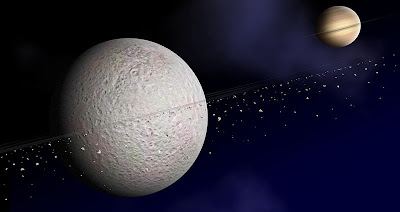Rings Around Rhea
 The Saturnian moon Rhea may have a tenuous ring system consisting of three narrow, relatively dense bands within a particulate disk. This would be the first discovery of rings around a moon. The discovery was announced in the journal Science on March 6, 2008.
The Saturnian moon Rhea may have a tenuous ring system consisting of three narrow, relatively dense bands within a particulate disk. This would be the first discovery of rings around a moon. The discovery was announced in the journal Science on March 6, 2008.In November of 2005 the Cassini orbiter found that Saturn's magnetosphere is depleted of energetic electrons near Rhea. According to the discovery team, the pattern of depletion is best explained by assuming the electrons are absorbed by solid material in the form of an equatorial disk, which contains within it several denser rings or arcs, of particles perhaps several decimeters to approximately a meter in diameter.
Voyager 1 observed a broad depletion of energetic electrons trapped in Saturn's magnetic field downstream from Rhea in 1980. These measurements, which were never explained, were made at a greater distance than the Cassini data.
On November 26, 2005, Cassini made the one targeted Rhea flyby of its primary mission. It passed within 500 km of Rhea's surface, downstream of Saturn's magnetic field, and observed the resulting plasma wake as it had with other moons, such as Dione and Tethys. In those cases, there was an abrupt cutoff of energetic electrons as Cassini crossed into the moons' plasma shadows (the regions where the moons themselves blocked the magnetospheric plasma from reaching Cassini). However, in the case of Rhea, the electron plasma started to drop off slightly at eight times that distance, and decreased gradually until the expected sharp drop off as Cassini entered Rhea's plasma shadow. The extended distance corresponds to Rhea's Hill sphere, the distance of 7.7 times Rhea's radius inside of which orbits are dominated by Rhea's rather than Saturn's gravity. When Cassini emerged from Rhea's plasma shadow, the reverse pattern occurred: A sharp surge in energetic electrons, then a gradual increase out to Rhea's Hill-sphere radius.
These readings are similar to those of Enceladus, where water venting from its south pole absorbs the electron plasma. However, in the case of Rhea, the absorption pattern is symmetrical.
In addition, the Magnetospheric Imaging Instrument (MIMI) observed that this gentle gradient was punctuated by three sharp drops in plasma flow on each side of the moon, a pattern that was also nearly symmetrical.
In August 2007, Cassini passed through Rhea's plasma shadow again, but further downstream. Its readings were similar to those of Voyager 1.
Comments